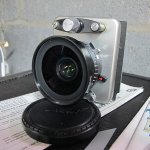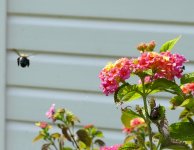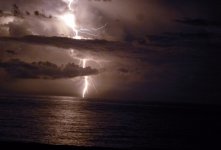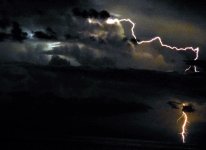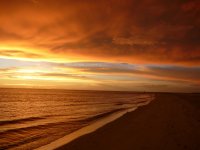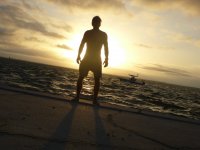Mostly I use a full frame sensor DSLR, so many advantages as has been said; but there is still no digital substitute for my 5 x 4 camera (all the movements!) and my 6 x 17cm panoramic. These still get fed film.
I have a Linhof Teknika 4x5 -- and this is my favorite lens -- Nikkor 65mm f/4 -- you don't have to bother focusing it.
Attachments
but I am going to stick with digital
In the 70's and 80's I had my own darkroom. It was set up for processing C41 (Kodacolor film) and printing and processing Ektacolor 74 (negative process paper). I had found a process in a magazine for "push processing" Ektachrome in a B&W developer like Diafine or even D76, skipping the reversal step and finishing the processing in a home made chemical brew. The results were unmasked color negatives that yielded high contrast color prints on ordinary Ektacolor paper.
My neighbor had a darkroom set up for E6 and Cibachrome processing. Printing on "plastic" paper from Ektachrome or Kodachrome slide film. We used each other's stuff, often having a slide night one day and a negative night another day.
Those days are gone.....They did "take the Kodochrome away."
I had a collection of old cameras in formats from 35mm to 6 x 7 CM including a Yashicamat TLR. Just prior to the decline in film, Sherri bought me a Canon SLR at the Incredible Universe (Tandy's attempt at Best Buy)going out of business sale.
My first digital was a Nikon Coolpix 880. It's still around here somewhere. I figured that anybody can make the electronics, get a camera from someone who could make lenses. Several interim cameras later I got a cheap Canon DSLR body on sale because the lenses from the old film camera fit it and work well.
I wanted a pocket camera for general use, so I bought a cheap Nikon Coolpix L10. Horrible camera that wouldn't take a sharp picture on a tripod in daylight! I then got a cheap Panasonic DSC-ZS15 to replace it. After almost 6 years it's still my most often used camera. It shoots 1080 video too.
I just got a Panasonic Lumix DSC-FZ1000. Not a DSLR, but has most of the DSLR features, a lens with a wide optical zoom range AND the ability to shoot 4K video. I haven't used it much yet since the planned trip to Florida got killed by Irma.
Why digital? Even in the days of home processing and printing, there is a finite cost associated with each press of the shutter button. We did a good job of minimizing that cost, but you just didn't mash that button randomly.
Digitally, there is no cost penalty except the cost of a new SD card every few years. I have been known to carry 2 batteries, take 500 to 1000 pictures and walk several miles on a picture journey. Even at that rate I got 4 years on a 128 GB card, and about a third of that was HD video.
So when you chase after a hummingbird, bumble bee, or that elusive bolt of lightning, you keep that shutter button pressed.
Everything here except the bee was shot with the $109 Panasonic ZS15 and all images have been compressed considerably to fit the forum requirements.
Attachments
I used to shoot 4x5 and even 8x10 film, but once I got my hands on the 4x5 digital backs, film was out the window! The digital is sooooo much cleaner, better color, lower noise. Now 8x10 film? Yeah, better than 4x5 digital, but not by much.... but there is still no digital substitute for my 5 x 4 camera...
My livelihood is digital video projection and I'm so glad to get away from film and even analog video. Apart from a really good, and rare, 70mm print, digital has it over film any day. The nostalgia is nice, but digital looks better.
OK, I never heard of that one! Figures you'd be doing it. How did you deal with no color mask? I thought the orange mask was there especially for the paper. If you could do it without, why was the mask there in color negative films?I had found a process in a magazine for "push processing" Ektachrome in a B&W developer like Diafine or even D76, skipping the reversal step and finishing the processing in a home made chemical brew. The results were unmasked color negatives that yielded high contrast color prints on ordinary Ektacolor paper.
Back in the 80s I remember a guy who used to shoot a Kodak S.O. film (Special Order). It was a C41 process negative, but with no orange color mask. He used it for reverse color slides. Maybe it was just re labeled cine film, but I don't think those used C41.
Push processing was pretty common in the old B&W days. There were special developers (Diafine, Accufine, etc) and extended development times at elevated temperatures. The recipes were printed in the photographic magazines of the day. I remember seeing a magazine cover in the camera shop where we got supplies that read "10,000 ASA!" and showed a COLOR picture of a moving train at night that appeared nearly stopped. I bought the magazine and the necessary ingredients on the spot. I had a couple of my pictures hanging in that shop for a month or two from those experiments. They all used Ektachrome, but yielded negatives.OK, I never heard of that one!
I thought the orange mask was there especially for the paper.
The orange mask brought the color balance into the range of the dichro heads (the heads with CYM knobs) on common enlargers and automated photo printing machines. I used large filters between the 400 watt bulb and the diffuser, so I had a large range of adjustment. It just took me a while and a bunch of contact strips to tweak it in.
I had a BIG old Italian Durst enlarger that was scrapped by a big litho shop in Miami when they went "digital", somewhere in the 70's. It had 5 X 7 INCH negative capability. I made an adaptor to fit "tiny" 35mm's. They gave me the enlarger and dozens of filters, lenses and accessories for it. I created a basic filter pack for C41 negatives, and another for those without mask. I had an extra filter drawer for tweaking the color balance for each new box of paper and sometimes different rolls of film. Kodacolor 100 was pretty consistent roll to roll when bought from the camera shop and kept in the fridge. The 400 stuff had just come out and was a bit less consistent. Fuji was different from Kodak, but not far off. I never could get good results from Agfa film or paper.
They had a large "Colormaster" machine that did color separation. A color slide or negative was inserted into a spinning drum. It was scanned into a "computer" (took about an hour) and then digitally separated into 4 dot images, C,Y,M, and black, which were then used generate 4 masks that would etch the printing plates.
That machine was made in Germany and it blew up a lot in a Florida lightning storm. After spending $1000 a pop for replacement PC boards that contained just a few large transistors, they asked me to see what I could do. I took a dead board and populated it with the biggest baddest transistors that Motorola made at the time and it never blew up again, hence all the free stuff.
Kodak S.O. film (Special Order). It was a C41 process negative, but with no orange color mask.
There was a "special film" sold in the back pages of the magazines of the day. It did not have a mask and claimed that the resolution was better because of it. Speculation was that it was indeed repackaged cine film. Most labs would not accept it for fear that it would pollute their chemistry. I never tried it or knew anyone who did.
I still have a Beseler-Minolta colorhead -- with the Beseler Enlarger.
An amazing thing for me -- my framer is Korean and my uncle who was stationed in Korea for 3 tours of duty shot Kodachrome over there, had it processed in Japan. After he passed away I found the slides and gave a bunch of them to Yan -- he scanned them and sent the files to relatives in Seoul who were just flabbergast -- Korea had no color film at that time. No fungus on the Kodachrome which had been stored in metal containers.
An amazing thing for me -- my framer is Korean and my uncle who was stationed in Korea for 3 tours of duty shot Kodachrome over there, had it processed in Japan. After he passed away I found the slides and gave a bunch of them to Yan -- he scanned them and sent the files to relatives in Seoul who were just flabbergast -- Korea had no color film at that time. No fungus on the Kodachrome which had been stored in metal containers.
Push processing was pretty common in the old B&W days. There were special developers (Diafine, Accufine, etc) and extended development times at elevated temperatures.
In high school, we routinely used Diafine to push Tri-X pan to 1600 ASA, sometimes higher, for night sports / indoor sports. Grain could get problematic, though, and contrast could be problematic.
We used Tri-X for pretty much everything.
A friend's father was a pathologist, and had a pretty decent darkroom at his office. We had really poor results processing our own ektachrome films with the '70's chemistry - couldn't manage the temperatures.
The Doc's used some really fine grain Kodak color film that escapes me at the moment, seems like it was 32 ASA or maybe even less. They did not process it on site.
They had some neat equipment - one machine would completely and automatically process and fix your exposed print ( stabilization processor ?).
They also used the lab space for storing, um, diseased innards, which was a little creepy. We were lectured once on the ills of smoking, while using a hunk of lung as a convenient ashtray for cigar ash.
Win W5JAG
24MP can happily print A1 sized prints. How about those house size advertising photos that we all see ?
For a long time cinemas stayed with film projection for that same reason. Today I believe that current CCDs have overcome the large screen problem ?? ( I stand to be corrected )
For a long time cinemas stayed with film projection for that same reason. Today I believe that current CCDs have overcome the large screen problem ?? ( I stand to be corrected )
Last edited:
.... Speculation was that it was indeed repackaged cine film.
5247 maybe? That ring any bells?
Win W5JAG
DLP is the projector chip. Also known as DMD Digital Mirror Device. 1000s of tiny mirrors that send the light out thru the lens, or not. The duty cycle of light to dark is what gives each pixel it brightness. 1 mirror per pixel times 3 colors, Red, Green, Blue.Today I believe that current CCDs have overcome the large screen problem
It's an amazing technology, brought to you by Texas Instruments.
George, thanks for the explanation. I knew about push processing, but never heard of anyone doing color printing from negs without a color mask. Using Ektachrome for that was clever.
 I had medium format color enlarger with the dials. That was time consuming enough, stacking filters must have taken forever.
I had medium format color enlarger with the dials. That was time consuming enough, stacking filters must have taken forever.I know drum scanners, from the same technology that brought us the AP Wireprint!
Could be, I tried to find mention of it on the web about 6 months ago, but the number just wouldn't come out of my brain. We ran it in C41 no problems. The guy who used it made what we would now do with PowerPoint. He could shoot black letters on a white background and get white on black. With a few filters he had a whole range of colors he could use on his slides.5247 maybe? That ring any bells?
Here is a neat old trick that is useful in our diy game. Assume that you have an old enlarger. You want to lift a PCB layout from a magazine, and it's not actual size. What do you do?
Using a test negative adjust the enlarger such that the image on the test negative is properly focused on a sheet of paper in the easel.
In a suitable dark room place a piece of unexposed film in the enlarger where the negative normally goes. Kodalith high contrast would be ideal. Place the magazine on the easel where you would normally put the paper to be exposed. Flash the room lights, or use a small camera flash unit aimed at the magazine article. Remove the now exposed film from the enlarger, develop it, then put it back into the enlarger and print it onto a sheet of Kodalith film. Use this to expose the PC board.
Using a test negative adjust the enlarger such that the image on the test negative is properly focused on a sheet of paper in the easel.
In a suitable dark room place a piece of unexposed film in the enlarger where the negative normally goes. Kodalith high contrast would be ideal. Place the magazine on the easel where you would normally put the paper to be exposed. Flash the room lights, or use a small camera flash unit aimed at the magazine article. Remove the now exposed film from the enlarger, develop it, then put it back into the enlarger and print it onto a sheet of Kodalith film. Use this to expose the PC board.
I've never shot Ectachrome. For slides I've only shot provia and velvia. I tended to use fuji for prints as well, press pro 400, and NPZ 800 for when I wanted high ISO. Did some experimenting with colour process black and white (Kodak TMAX 400) as well.
Most of that with a Nikon F80, though the B&W was on a konika autoreflex T.
Once I got my Nikon D80, despite the fact it could not match the resolution of 100 ISO provia, the convenience was just too great, and I pretty much stopped shooting film. In fact there is still an unfinished B&W film in my Konica from around 2006 I think. Probably completely gone off. I think every now and again, I should finish it and get it processed but never get around to it.
I got a Nikon D750 a while back and what a leap!! It would rival a 4000dpi scan of provia 100F I think, and be pretty much grainless. Probably better dynamic range as well.
That was something that early digital definitely couldn't match (dynamic range of a good slide on a good projector). But good monitors with good DLSR's these days (or I imagine a good digital projector) I think probably are starting to rival the best of slides.
edit: I always carried a notebook when shooting film. recording location, fstop. shuter speed and frame number so when I got the film developed I could work out what went wrong if bad, or what was right if it was a good shot. I used to work off the basis that I was happy if I got one shot in a roll of 36 that I thought was pretty good. It certainly did make you think a lot more before taking a shot. Digital with it's instant feedback does make me lazy.
Tony.
Most of that with a Nikon F80, though the B&W was on a konika autoreflex T.
Once I got my Nikon D80, despite the fact it could not match the resolution of 100 ISO provia, the convenience was just too great, and I pretty much stopped shooting film. In fact there is still an unfinished B&W film in my Konica from around 2006 I think. Probably completely gone off. I think every now and again, I should finish it and get it processed but never get around to it.
I got a Nikon D750 a while back and what a leap!! It would rival a 4000dpi scan of provia 100F I think, and be pretty much grainless. Probably better dynamic range as well.
That was something that early digital definitely couldn't match (dynamic range of a good slide on a good projector). But good monitors with good DLSR's these days (or I imagine a good digital projector) I think probably are starting to rival the best of slides.
edit: I always carried a notebook when shooting film. recording location, fstop. shuter speed and frame number so when I got the film developed I could work out what went wrong if bad, or what was right if it was a good shot. I used to work off the basis that I was happy if I got one shot in a roll of 36 that I thought was pretty good. It certainly did make you think a lot more before taking a shot. Digital with it's instant feedback does make me lazy.
Tony.
Last edited:
I used to shoot 4x5 and even 8x10 film, but once I got my hands on the 4x5 digital backs, film was out the window!
Which one do you use..? I've not looked at what's available for a while
Film wise, kodak Tech Pan was always my favourite - you could push that so far it's like digital. I still have some - it's still good! I even did some colour work with it in the 5 x 4 -- the alignment was a nightmare though at the time. Easy now though if you scan in the neg!
You forget the light sensitivity. Hard to get ISO 400000 from film.I did my degree in photography, all analogue - 35mm, medium and large format. The biggest difference for me between digital and analogue photography is the feedback time - you can look at the pictures while you still remember the decisions you made about depth of field, composition etc and learn from your mistakes. If you can take 100 shots, look at them within 10 minutes and take 100 more you're going to learn quicker and take better photos.
That said, I prefer a decent print from a 5x4 plate over digital any time.
I've used 3. BetterLight and its ancestor the DichoMed (spelling?). I spent to the most time on a Phase One 4x5 back. It's a true full RGB 100 megapixel image, not a matrix like a DSLR chip.Which one do you use..? I've not looked at what's available for a while
But here's the problem - they are all scanning backs, not real time or single shot. It can be difficult to photograph anything that moves as it takes a few seconds to do a scan, just like a flatbed scanner. I used them for photographing paintings in fine art printing.
There is another forum member here who shoots with a Phase One back, nit sure that he does
Also, there is a panoramic attachment for the back which does amazing images. I've never used it, but the images are glorious.
Oh, and thanks for the Tech Pan mention. That brings back memories.

Yes, it's a shame they have to scan - but a massive array of sensors would be horribly expensive! I use it for mostly landscapes, but there's enough movement - trees, the odd bird - that it might be a problem. I'll have to see if I can rent one to try - this is all your fault, you've whet my appetite now!! 
Can be. Palm tree leaves were always the hardest for me. Cars can be trouble, too. Most things in the distance are OK.I use it for mostly landscapes, but there's enough movement - trees, the odd bird - that it might be a problem.
It would be fun for you to rent one. Be sure you get an IR filter, the sensors don't have them, unless things have changed. Ours stayed attached to the back of the lens with rubber bands.
A 100 megapixel 12 bit scan is a BIG file, at least in image terms.
So can Ektachrome:
The Return of Kodak Ektachrome Film is Nigh
Note -- you can still get Provia and Velvia.
One of my sons figured that for him, it was less expensive to shoot film than purchase a new kilo-buck$ D-SLR.
I always preferred Kodachrome to Ektachrome. The blue blacks of Ektachrome just seemed wrong.
G²
- Status
- This old topic is closed. If you want to reopen this topic, contact a moderator using the "Report Post" button.
- Home
- Member Areas
- The Lounge
- If vinyl can make a come-back
